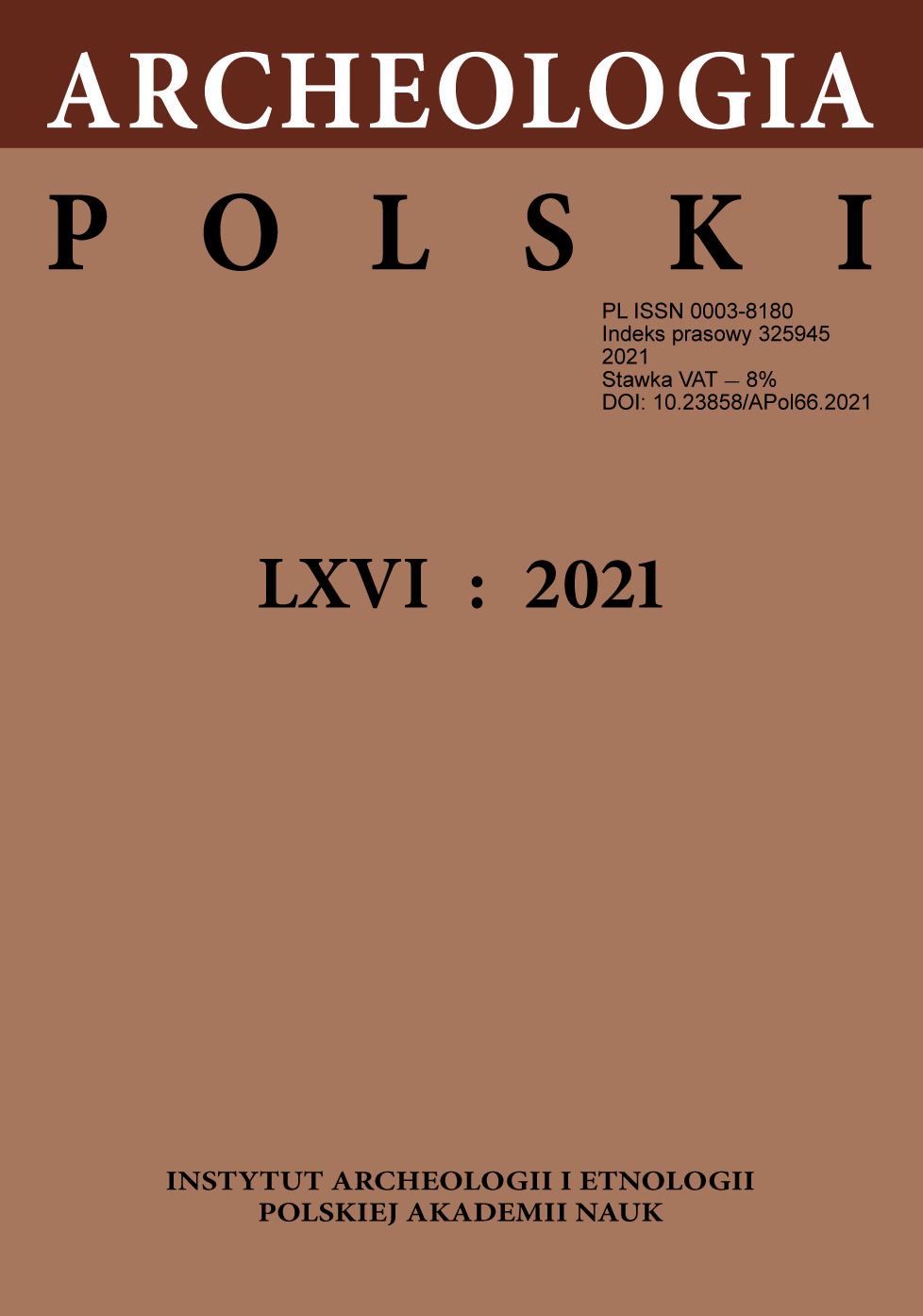The quest for palaeolithic art in the Neris river valley, Central-Eastern Lithuania
DOI:
https://doi.org/10.23858/APol66.2021.005Słowa kluczowe:
Final Palaeolithic, mobile art, engraved pebble, blade with notches, flint figurine, MesolithicAbstrakt
Only a few artifacts discovered in Lithuania can be considered as examples of portable art from the Final Palaeolithic period. Three of them were found in the Neris river valley in central-eastern Lithuania: an engraved slate pebble from the Eiguliai 1А site, a notched blade from the Skaruliai 1 site, and a flint “figurine” from the Vilnius 1 site. Discovered by Rimutė Rimantienė and her father Konstantinas Jablonskis, these three finds were the first and for many years the only artifacts underpinning the discussion of art from the Lithuanian Final Palaeolithic. The debate on the tentative function of these items, initiated by Rimantienė, is reviewed in this study before presenting the results of the latest research on the subject between 2012 and 2017, carried out using a range of methods: visual examination, comparative analysis with other archaeological finds and reconstructed prehistoric tools, surface analysis under a microscope. The functional interpretation proposed as a result of these investigations in two cases disproves the identification of these artifacts as portable art.
Pobrania
Bibliografia
Bednařik R . G . 1996, Crisis in Palaeolithic art studies, „Anthropologie”, 34/1, pp. 123–130.
Berthelsen W. 1944, Stenalderbopladser i Sønderkær og Vejledalen: Bidrag til Kendskabet til den mesolitiske Kulturperiode i Sydøstjylland, Kopenhagen.
Bokelmann K . 1971, Duvensee, ein Wohnplatz des Mesolithikums in Schleswig-Holstein, und die Duvenseegruppe, “Offa”, 28, pp. 5–26.
de Beaune S . A . 2000, Pour une archéologie du geste. Broyer, moudre, piler. Des premiers chasseurs aux premiers agriculteurs, Paris.
Bordaz J . 1970, Tools of the Old and New Stone Age, New York.
Boriskovs’kii P. I . 1949, Paleolit i neolit Ukrainy, Arkheologichni doslidy na Desni, 1, Кiev.
Boroń T. , Królik H . , Kowalski T. 2011, Antropomorficzna plastyka figuralna krzemienna i kościana w społecznościach pradziejowych z ziem polskich, „Archeologia Polski”, 56, pp. 65–88.
Boroń T. , Królik H . , Kowalski T. 2014, Female Figurines, [in:] Wilczyce. A Late Magdalenian winter hunting camp in Southern Poland, R. Schild ed., Warsaw, pp. 319–334.
Brézillon M . N . 1968, La dénomination des objects de pierre taillée: matériaux pour un vocabulaire des préhistoriens de langue française, IVe supplément à “Gallia préhistoire”, Paris.
Capitan L . 1922, La Préhistoire, Collection Payot, Paris.
Clark J . G . D. 1936 (2014), The Mesolithic settlement of Northern Europe, Cambridge.
Clarke A . , Vila A . , Estevez J . , Hardy K . 2012, The tie that binds? An incised Mesolithic bevelled pebble from Camas Daraich, Skye, „Mesolithic Miscellany”, 22/1, pp. 3–9.
Cook J . 2013, Ice Age art: arrival of the modern mind, London.
Dürre W. 1971, Fundplätze der Ahrensburger Kultur im Kreise Soltau, Materialhefte zur Vor-und Frühgeschichte Niedersachsens, 4, Hildesheim.
Fiedorczuk J . , Bratlund B . , Kolstrup E . , Schild R . 2007, Late Magdalenian feminine flint plaquettes from Poland, „Antiquity”, 81, pp. 97–105.
Fiedorczuk J . , Schild R . 2002, Wilczyce: a new Late Magdalenian site in Poland, [in:] Recent studies in the Final Palaeolithic of the European plain, Proceedings of a U.I.S.P.P. Symposium, Stockholm, 14–17 October 1999, E.V. Eriksen, B. Bratlund eds., Jutland Archaeological Society, 39, pp. 91–100.
Gehlen B . 2012, Grundformproduktion und -verwendung im späten Mesolithikum Mitteleuropas, [in:] Steinartefakte vom Altpaläolithikum bis in die Neuzeit, H. Floss ed., Tübingen, pp. 549–580.
Girininkas A . 2009, Lietuvos archeologija: Akmens amžius, 1, Vilnius.
Gudaitienė G . 2018, The first inhabitants in the western part of the Neris river basin in Lithuania, manuscript of a Doctor thesis in the Archive of the Vilnius University, Vilnius.
Gvozdover M . D. , Leonova N . B . 1977, Klad kremnya iz verkhnepaleoliticheskoi stoyanki Kamennaya Balka II, [in:] Problemy paleolita vostochnoi i central‘noi Evropy, pp. 127–136.
Jablonskytė R . 1941, Akmens amžiaus stovykla Skaruliuose (Jonavos v., Kauno a.), Vytauto Didžiojo Kultūros muziejaus metraštis, 1, Kaunas, pp. 13–14.
Juodagalvis V. 2008, Mezolitas, [in:] Lietuvos istorija. Akmens amžius ir ankstyvasis metalų laikotarpis, 1, Dž. Brazaitis, A. Girininkas, V. Juodagalvis, T. Ostrauskas, Vilnius, pp. 49–101.
Kashina E . 2002, Anthropomorfic flint sculpture of the European Russian forest zone, „Anthropologica et Praehistorica”, 113, pp. 51–60.
Kowalski K . , Płonka T. 2009, New ornamented artefacts from the Polish Lowland and Final Palaeolithic symbolism, [in:] Humans, environment and chronology of the Late Glacial of the North European Plain, Proceedings of Workshop 14 (Commission XXXII »The Final Palaeolithic of the Great European Plain / Le Paléolithique Final de la Grande Plaine Européenne«) of the 15th U.I.S.P.P. Congress, Lisbon, September 2006, M. Street, N. Barton, T. Terberger eds., Römisch-Germanisches Zentralmuseum – Tagungen, 6, Mainz, pp. 179–187.
Marshack A . 1970, New techniques in the analysis and interpretation of Mesolithic notation and symbolic art, [in:] Actes du Symposium International d’Art Préhistorique, Valcamonica, 23–28 September 1968, E. Anati ed., Capo di Ponte, pp. 479–494.
Marshack A . 1980, European Upper Palaeolithic–Mesolithic symbolic continuity: A cognitive, comparative study of ritual marking, [in:] Acts of the Valcamonica Symposium’79: the intellectual expressions of prehistoric man: art and religion, E. Anati ed., pp. 111–119.
Merino J . M . 1980, Tipologia litica, „Munibe Antropologia – Arkeologia”, Suplemento No. 4, Sociedad de Ciencias Aranzadi, pp. 251–253.
Milisauskas S . ed . 2002, European prehistory: a survey, New York.
Nedomolkina N . G . 2000, Sukhonskie kremnevye figurki, [in:] Tverskoi Arkheologicheskii Sbornik, 4/1, pp. 224–232.
Pales L . 1981, Les gravures de la Marche, 1–4, Bordeaux.
Pershits А . I . , Mongait A . L . , Alekseev V. P. 1974, Istoriya pervobytnogo obshchestva: Uchebnik, Moskva.
Pigeot N . 2004, Les derniers magdaléniens d’Étiolles. Perspectives culturelles et paléohistoriques, „Suplement Gallia Préhistoire”, 37.
Płonka T. 2003, The portable art of the Mesolithic Europe, Wrocław.
Rimantene R . K . 1971, Paleolit i mezolit Litvy, Vilnius.
Rimantienė R . 1984, Akmens amžius Lietuvoje, Vilnius.
Rimantienė R . 1996, Akmens amžius Lietuvoje, Vilnius.
Rimantienė R . (not dated), Written depiction of Eiguliai 1A site, manuscript in the Archive of the National Museum of Lithuania, Vilnius.
Rimkus T. , Butrimas A . , Iršėnas M . , Meadows J . 2019, The decorated spindle-shaped bone dagger from Šarnelė: The earliest example of hunter-gatherer mobile art in Lithuania, „Archaeologia Baltica”, 26, Klaipėda, pp. 50–62.
Rimkutė G . 2012, Netitnaginių uolienų apdirbimo technologijos ir dirbinių gamyba finaliniame paleolite-mezolite Lietuvoje, „Archaeologia Lituana”, 13, Vilnius, pp. 29–65.
Schild R . 2009, Paleolityczne figurki kobiet z Wilczyc, „Archeologia Żywa”, 4, pp. 8–11.
Schmidt R . R . 1922, Die Kunst der Eiszeit, Tübingen.
Séara F. , Rotillon S . , Cupillard Ch . eds . 2002, Campements mésolithiques en Bresse jurassienne: Choisey et Ruffey-sur-Seille (Jura), Documents d’archéologie française, 92, Paris.
Shovkoplyas I . G . 1965, Mezinskaya stoyanka, Kiev.
Sieveking A . 1987, Engraved Magdalenian Plaquettes: a regional and stylistic analysis of stone, bone and antler plaquettes from Upper Palaeolithic sites in France and Cantabric Spain, BAR International Series, 369.
Sjöström A . , Nilsson B . 2009, ‘Rulers’ of southern Sweden: technological aspects of a rediscovered tool, [in:] Mesolithic horizons. Papers presented at the Seventh International Conference on the Mesolithic in Europe, Belfast 2005, S.B. McCartan, R. Schulting, G. Warren, P. Woodman eds., 2, pp. 788–794.
Street M . , Gelhausen F. , Grimm S . , Moseler F. , Niven L . , Sensburg M . , Turner E . , Wenzel S . , Jöris O. 2006, L’occupation du bassin de Neuwied (Rhénanie centrale, Allemagne) par les Magdaléniens et les groupes à Federmesser (aziliens), „Bulletin de la Société préhistorique française”, 103/4, pp. 753–780.
Šatavičius E . 2001, Vėlyvojo paleolito kultūros ir jų likimas ankstyvajame mezolite, manuscript of the Doctor thesis in the Archive of the Vilnius University, Vilnius.
Šatavičius E . 2005, Svidrų kultūra Lietuvoje, „Lietuvos archeologija”, 29, pp. 133–170.
Taute W. 1968, Die Stielspitzen-Gruppen im nördlichen Mitteleuropa. Ein Beitrag zur Kenntnis der späten Altsteinzeit, Fundamenta: Monographien zur Urgeschichte, Rheie A-5, Köln–Graz–Böhlau.
Tymula S . 2002, L’art solutréen du Roc de Sers (Charente), Documents d’archéologie française, 91, Paris.
Veil S . , Breest K . , Grootes P. , Nadeau M .- J. , Hüls M . 2012, A 14 000-year-old amber elk and the origins of northern European art, „Antiquity”, 86, pp. 660–673.
Villaverde Bonilla V. 1994, Arte paleolitico de la Cova del Parpallo. Estudio de la coleccion de plaquetas y cantos grabados y pintados, 2, València.
Weniger G . - C . 1989, The Magdalenian in Western Central Europe: Settlement Pattern and Regionality. „Journal of World Prehistory”, 3, pp. 323–372.
Wildgen W. 2004, The Paleolithic origins of art, its dynamic and topological aspects, and the transition to writing, [in:] M.M.H. Bax, B.P. van Heusden, W. Wildgen, Semiotic Evolution and the Dynamics of Culture, Bern, pp. 111–148.
Zamyatnin S . N . 1948, Minyaturnye kremnevye skul’ptury v neolite severo-vostochnoi Evropy, „Sovetskaya arkheologiya”, 10, pp. 85–123.

















